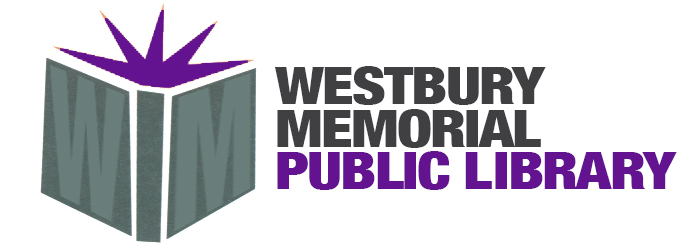Librarian's Pick
Here's what our librarians are reading lately.Librarian’s Pick: The Innocents – Michael Crummey
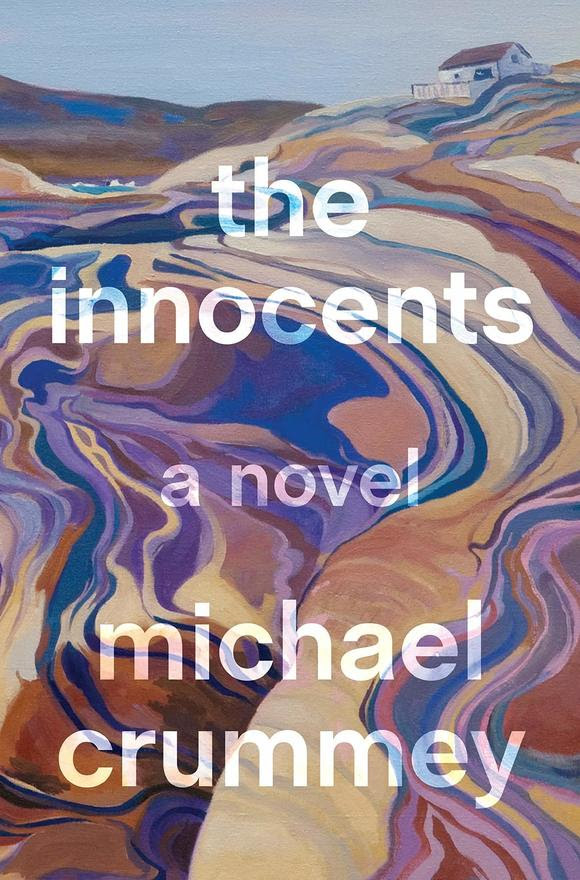 “Award-winning poet and novelist Michael Crummey’s work draws imaginatively from the history and landscape of his native Newfoundland. The Innocents, his fifth novel, is the riveting story of an orphaned brother and sister whose relationship is tested by hardship and isolation in 19th-century coastal Labrador.
“Award-winning poet and novelist Michael Crummey’s work draws imaginatively from the history and landscape of his native Newfoundland. The Innocents, his fifth novel, is the riveting story of an orphaned brother and sister whose relationship is tested by hardship and isolation in 19th-century coastal Labrador.
Ada and Evered Best live in a cove in the far northern province. Their home is a stretch of rocky coast with a simple shelter, and they survive with only the most rudimentary information passed down by their parents. The siblings support themselves by catching and salting cod, which they trade for supplies twice a year, as well as by tending a small garden and trapping the occasional animal for meat. The repetition of the changing seasons defines the pair’s existence—the breaking of the ice at the end of the long winter, the return of the cod, the annual gorging on the sweet berries that grow wild farther inland. As the years pass, their relationship changes, and when they enter puberty, their connection becomes more complicated. Though Ada and Evered once welcomed the occasional visitors who found their way to their coastline, their intimacy, developed in innocence, seems shameful in the light of even the most casual observation.
Crummey found the inspiration for the novel from an archival passage by a traveling clergyman who met an orphaned brother and sister living in a remote northern cove. When the clergyman approached them, the boy drove him away at gunpoint. Crummey has transformed this fragment into a richly fashioned story told with great sensitivity—one that is as credible as it is magical.
The Innocents reminds us of all the reasons we read—to understand, to imagine, to find compassion and to witness the making of art.”
Librarian’s Pick: Ordinary Girls – Jaquira Diaz
 “Jaquira Díaz’s Ordinary Girls reaches deep into your heart and seizes your emotions from the very first sizzling paragraph. And as it carries you into some of Díaz’s darkest shadows and out into variegated light, it refuses to let go. In staccato sentences, Díaz walks us through her community: “We were the girls who strolled onto the blacktop on long summer days, dribbling past the boys on the court. . . . We were the wild girls who loved music and dancing. Girls who were black and brown and poor and queer. Girls who loved each other.”
“Jaquira Díaz’s Ordinary Girls reaches deep into your heart and seizes your emotions from the very first sizzling paragraph. And as it carries you into some of Díaz’s darkest shadows and out into variegated light, it refuses to let go. In staccato sentences, Díaz walks us through her community: “We were the girls who strolled onto the blacktop on long summer days, dribbling past the boys on the court. . . . We were the wild girls who loved music and dancing. Girls who were black and brown and poor and queer. Girls who loved each other.”
In fiercely honest prose, Díaz turns back every page of her life, starting with growing up in El Caserío Padre Rivera, the government housing projects in Puerto Rico, and sharing stories from there that she “never wants to forget.” In this world, Díaz learns about danger and violence and death, but she also learns about community. She yearns for a more loving family and home, but her mother and father can provide only a soundtrack of constant bickering and yelling. There’s no love lost between Díaz and her brother, who beats her and abuses her emotionally and whom she tries to kill with a steak knife.
When the family moves to Miami Beach, life looks a little sunnier because they’ve moved up financially, but only for a moment. Her mother and father split, and her mother sinks into addiction that’s exacerbated by schizophrenia. Díaz eventually escapes the violence through an early marriage, a stint in the Navy and enrollment in college and creative writing courses, though she never sheds her friendships, her family or her memories.
The stunning beauty of Díaz’s memoir grows out of its passion, its defiance, its longing, its love and its clear-eyed honesty. Díaz’s story hums with a vibrant beauty, shining a light out of the darkness that shadowed her life.”
Librarian’s Pick: The Starless Sea – Erin Morgenstern
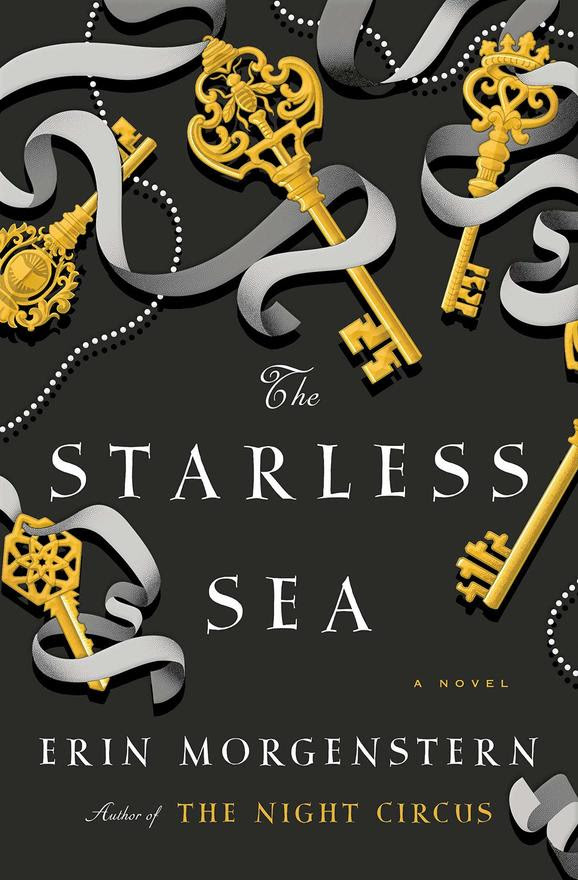 “As graduate student Zachary Ezra Rawlins contemplates which book to choose in his university library, he muses that reading a novel “is like playing a game where all the choices have been made for you ahead of time by someone who is much better at that particular game.” That’s certainly the case when the author in question is Erin Morgenstern, who mesmerized readers with her breakout debut, The Night Circus, and now returns with her highly anticipated second novel, The Starless Sea, a grand fantasy about books, the power of literature and storytelling.
“As graduate student Zachary Ezra Rawlins contemplates which book to choose in his university library, he muses that reading a novel “is like playing a game where all the choices have been made for you ahead of time by someone who is much better at that particular game.” That’s certainly the case when the author in question is Erin Morgenstern, who mesmerized readers with her breakout debut, The Night Circus, and now returns with her highly anticipated second novel, The Starless Sea, a grand fantasy about books, the power of literature and storytelling.
The mysterious book Zachary ends up choosing features him as a character and leads him on an epic quest, first to the Algonquin Hotel Annual Literary Masquerade in New York City and ultimately through a secret doorway to a subterranean realm where he finds pirates, an Owl King, fairy tales, a story sculptor and “an underground trove of books and stories beneath their feet.” Think Harry Potter for book lovers and grown-ups. (Zachary’s favorite drink is a sidecar, and he falls in love during his adventures.) There are literary references galore, as well as an undertone of video games. “Is that Zelda for Princess or Fitzgerald?” Zachary asks at one point. The response he receives: “Little bit of both.”
Paralleling Susan Orlean’s The Library Book, a nonfiction ode to books, libraries and librarians, The Starless Sea is a fictional journey dedicated to stories and storytelling. Both are lively, inventive titles chock-full of book-centric quotes.
This hefty novel requires imaginary leaps and careful attention to stories and characters that wind their way in many different directions, but Morgenstern—now proving not once, but twice, what an adept literary juggler she is—manages to weave a multitude of strands together into one mighty, magical tale.”
Librarian’s Pick: In The Dream House – Carmen Maria Machado
 “Queer history is both old and new. We have been gay since the dawn of time, but only recently have queer people really started to speak our own stories into the historical record. The novelty of this—as well as the precarious lives many LGBTQ people still live—raises its own questions: Which stories do we tell? Relative to established narrative forms, where and how do they fit? What about the bad parts?
“Queer history is both old and new. We have been gay since the dawn of time, but only recently have queer people really started to speak our own stories into the historical record. The novelty of this—as well as the precarious lives many LGBTQ people still live—raises its own questions: Which stories do we tell? Relative to established narrative forms, where and how do they fit? What about the bad parts?
“I enter into the archive that domestic abuse between partners who share a gender identity is both possible and not uncommon, and that it can look something like this,” Carmen Maria Machado writes at the beginning of her stunning new memoir, In the Dream House. “I speak into the silence.” The book describes the arc of a romantic relationship turned sour, controlling and claustrophobic, the house of its title becoming a place where Machado locks herself in the bathroom while her girlfriend tries to break down the door.
To call it a memoir, though, is to give short shrift to the exquisite strangeness and formal innovation that Machado achieves. The author of Her Body and Other Parties—a National Book Award-nominated collection of stories combining elements of fable, fantasy, noir, erotic thriller, science fiction and fairy tale—Machado imports her fascination with genre into In the Dream House. Each of the book’s short chapters nods to some trope or narrative tradition that Machado is playing with—“American Gothic” or “Lesbian Pulp Novel.” This is a clever device, but it’s also a propulsive one, and occasionally leavening. One chapter is precisely one sentence long: “‘We can fuck,’ she says, ‘but we can’t fall in love.’” Its title is “Dream House as Famous Last Words.”
If this all sounds very metatextual, know that Machado has pulled off an amazing feat: a book that comments on its own existence and the silences it endeavors to fill; a work deeply informed by a sense of identity and community; and page after page of flawless, flaying, addictive prose. In the Dream House is astonishingly good.”
Librarian’s Pick: Nothing to See Here – Kevin Wilson
 “Kids are unpredictable. They suddenly love food they once thought disgusting. And sometimes they just might spontaneously combust.
“Kids are unpredictable. They suddenly love food they once thought disgusting. And sometimes they just might spontaneously combust.
In Nothing to See Here, Kevin Wilson doesn’t dwell on the science of human combustion. Instead, he uses the phenomenon as a clever metaphor for human behavior, especially as it relates to a seemingly privileged family.
Lillian Breaker, the novel’s 28-year-old narrator, is anything but privileged. She grows up poor in Tennessee but is determined to seek a better life, so she earns a scholarship to the prestigious Iron Mountain Girls Preparatory School. She develops a fast friendship with Madison Billings, a rich girl whose family owns a chain of department stores. They’re classmates for a year, until another student rats on Madison for having cocaine in her room. The Billings family’s solution? Bribe Lillian’s mother and get Lillian to take the rap.
The young women go their separate ways until years later, when Madison is the wife of a senator who had twins with a previous spouse. The senator is eager to assume higher political office, but the 10-year-old twins are a liability. Whenever something upsets them, they burst into flames, damaging everything around them but leaving their own bodies unharmed. Madison hires Lillian to live on the family estate and act as governess to the two children. What follows is a series of revelations for all parties, as Lillian discovers untapped maternal instincts and Madison and her husband learn more about their family dynamics.”
Librarian’s Pick: The Life And Afterlife Of Harry Houdini – Joe Posnanski
 “The Life and Afterlife of Harry Houdini is hardly a typical biography; it’s more like taking an up-close-and-personal tour of the escape artist’s life, narrated not only by author Joe Posnanski in his wonderfully entertaining prose but also by a host of colorful experts whom the author tracks down.
“The Life and Afterlife of Harry Houdini is hardly a typical biography; it’s more like taking an up-close-and-personal tour of the escape artist’s life, narrated not only by author Joe Posnanski in his wonderfully entertaining prose but also by a host of colorful experts whom the author tracks down.
Posnanski says he was drawn to the legendary escape artist because he “sparks so much wonder in the world, even today.” Modern magicians seem to concur that, technically speaking, Houdini wasn’t a particularly good magician. However, crowds were mesmerized by his escapes and were convinced he could do the impossible. The great actress Sarah Bernhardt was so gobsmacked that she asked if Houdini could restore her missing leg.
The truth of the matter is that Houdini was a charismatic, brilliant entertainer who was obsessed with fame. This publicity genius was ruthless against critics and competitors and could not for the life of him ignore an insult. He loved making money but wore tattered clothes, preferring to spend his money on self-promotion, magic books and paraphernalia.
Even today, Houdini “lives on because people will not let him die,” Posnanski writes. He introduces readers to a variety of Houdini’s modern disciples, such as Kristen Johnson, “Lady Houdini,” who says that after she tried her first rope escape, “she felt alive in a whole different way.” Magician David Copperfield takes Posnanski on a tour of his private museum in Las Vegas, discussing his predecessor’s influence. Australian magician Paul Cosentino admits, “I guess . . . he saved my life. Little boys like me, we need Houdini, you know? He’s a symbol of hope.” As Posnanski concludes, “Houdini is not a figure of the past. He is a living, breathing, and modern phenomenon.”
Librarian’s Pick: The Body – Bill Bryson
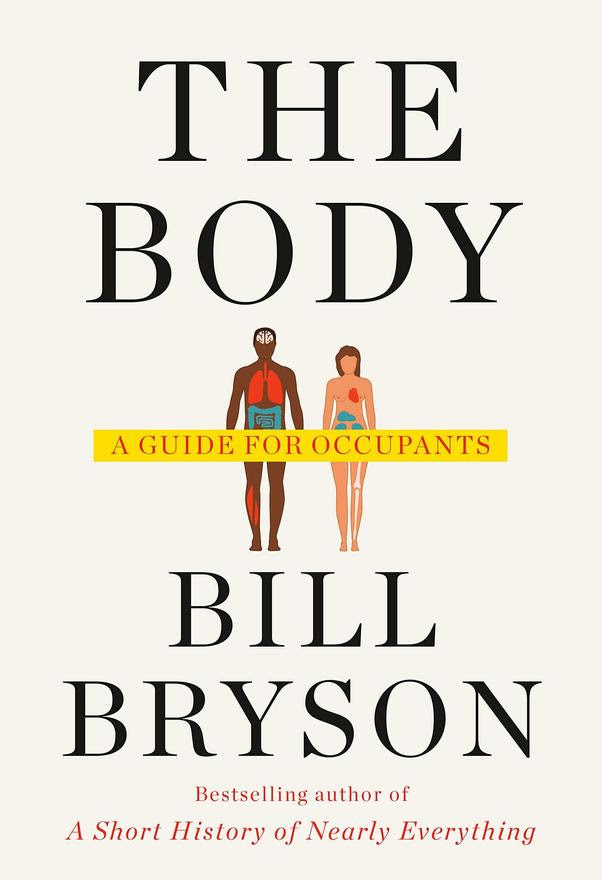 “In his latest book, The Body: A Guide for Occupants, Bryson divides the body’s various parts and processes into 23 chapters, with subject headings such as “The Heart and Blood,” “The Guts” and “Nerves and Pain.” Each relatively short chapter is chock-full of clear, in-depth explanations of the body and its components, focusing just the right amount of facts and attention on each area to keep the reader riveted and eager to dive into the next topic.
“In his latest book, The Body: A Guide for Occupants, Bryson divides the body’s various parts and processes into 23 chapters, with subject headings such as “The Heart and Blood,” “The Guts” and “Nerves and Pain.” Each relatively short chapter is chock-full of clear, in-depth explanations of the body and its components, focusing just the right amount of facts and attention on each area to keep the reader riveted and eager to dive into the next topic.
As with his previous writings, Bryson demonstrates his gift for putting science in layman’s terms, deftly melding the most incredible statistics with wit to expose humorous and fascinating aspects of the human condition. He relates these nuggets of information to everyday life, such as when he compares a cell to a little room that is “of itself as nonliving as any other room.” Yet when combined with the busy, also nonliving things housed within its walls—such as proteins, DNA and mitochondria—life is created.
Throughout the book, Bryson highlights parts of the human physique that are mysteries even to doctors and scientists. He creatively intertwines amazing medical advances, such as transplant surgery and antibiotics, with topics that are still very much unknown, such as the immune system and allergies. It’s rather humbling to realize that there’s so much we don’t know about the place that houses all of our thoughts, feelings and physical attributes. As Bryson so effectively conveys in The Body, we truly are a work in progress.”
Librarian’s Pick: Your House Will Pay – Steph Cha
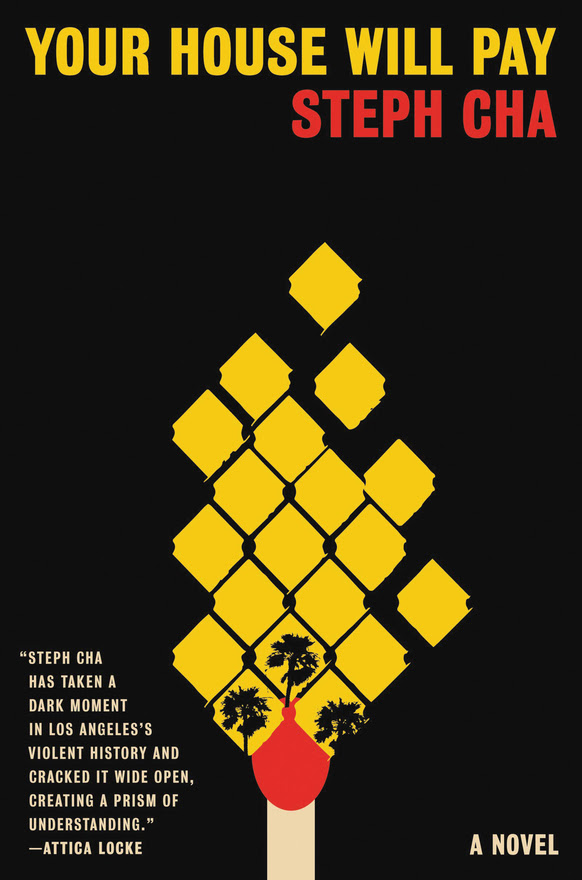 “Steph Cha’s nerve-scraping novel—with its biblical, plangent title and painfully relevant plot—could be described as triggering, depending on the reader. Your House Will Pay is based on a particularly sickening episode during a particularly sickening period in American history. In 1991 Los Angeles, Korean grocery store owner Soon Ja Du shot 15-year-old Latasha Harlins in the back of the head after accusing her of stealing. The horror was caught on video, and although Du was convicted of voluntary manslaughter, she never went to jail.
“Steph Cha’s nerve-scraping novel—with its biblical, plangent title and painfully relevant plot—could be described as triggering, depending on the reader. Your House Will Pay is based on a particularly sickening episode during a particularly sickening period in American history. In 1991 Los Angeles, Korean grocery store owner Soon Ja Du shot 15-year-old Latasha Harlins in the back of the head after accusing her of stealing. The horror was caught on video, and although Du was convicted of voluntary manslaughter, she never went to jail.
Who was this woman who pulled the trigger? Who was the girl she shot? To answer this, Cha has fictionalized the players, with Du turned into Yvonne Park and Harlins into Ava Matthews, and has brought them to life through the eyes of their loved ones. In Yvonne’s case, this means her taciturn husband, Paul, and their daughters, Miriam and Grace. After Yvonne kills Ava, the Parks escape into anonymity. They run a tiny pharmacy in a mall filled with modest Korean businesses and keep to themselves.
As for Ava, she and her brother, Shawn, were raised by their aunt Sheila after the death of their mother. Sheila’s son, Ray, is more like a brother than a cousin. The comings and goings of this African American family are far more dramatic than those of the reclusive Parks. Shawn and Ray have been in and out of gangs and, unlike Yvonne, in and out of jail. For most of the book, they’re middle-aged and determined to stay on the straight and narrow. Ray is a husband to the faithful Nisha and a father to their children, and Shawn is helping his girlfriend raise her adorable toddler. Then something terrible happens, and the Parks and the Matthewses are thumped back to square one.
The heart of the book is how alike these people are. They work, they eat, they pray, they love; their devotion to their families is painful. They are caught up in a racial pathology that came into play long before the Parks emigrated to America and before any member of the Matthews family was born. That pathology led them to turn on each other.
What Cha wants the reader to understand through her straightforward prose is that none of what happened between these two families had to happen, and everybody’s house pays.”
Librarian’s Pick: Noel Street – Richard Paul Evans
 “The year is 1975. Elle Sheen—a single mother who is supporting herself and her six-year-old, African-American son, Dylan, as a waitress at the Noel Street Diner—isn’t sure what to make of William Smith when his appearance creates a stir in the small town of Mistletoe, Utah. As their lives unexpectedly entwine, Elle learns that William, a recently returned Vietnam POW, is not only fighting demons from his past, but may also have the answer to her own secret pain—a revelation that culminates in a remarkable act of love and forgiveness.”
“The year is 1975. Elle Sheen—a single mother who is supporting herself and her six-year-old, African-American son, Dylan, as a waitress at the Noel Street Diner—isn’t sure what to make of William Smith when his appearance creates a stir in the small town of Mistletoe, Utah. As their lives unexpectedly entwine, Elle learns that William, a recently returned Vietnam POW, is not only fighting demons from his past, but may also have the answer to her own secret pain—a revelation that culminates in a remarkable act of love and forgiveness.”
Librarian’s Pick: Monster, She Wrote – Lisa Kroger & Melanie R. Anderson
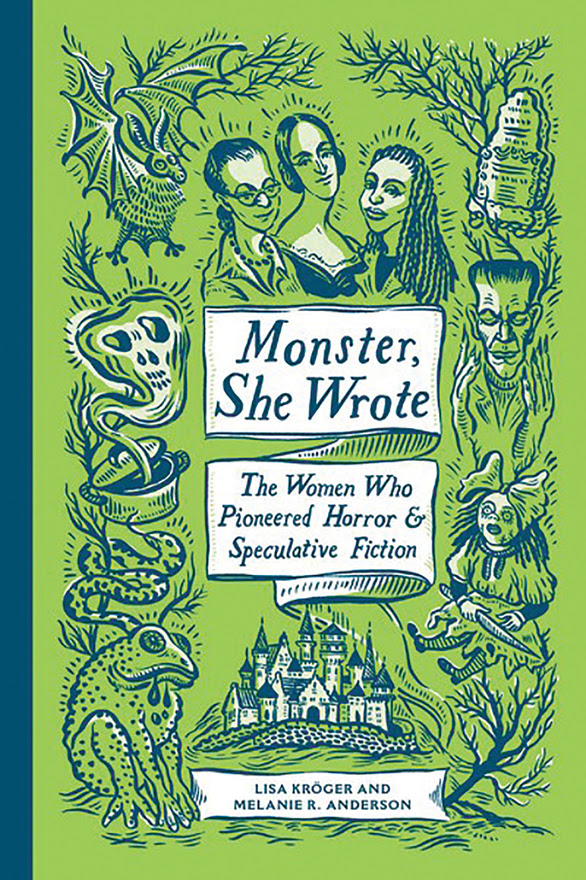
“In Monster, She Wrote: The Women Who Pioneered Horror and Speculative Fiction, scholars of the weird Lisa Kröger and Melanie R. Anderson trace the genealogy of women who’ve dealt in the unsettling, from the 17th century into the present. This book is inspired not only in the way it explores what the off-kilter, the monstrous and the half-known has meant to women for centuries but also in how it illuminates the often unusual lives of the women who crafted these dark worlds. Amelia Edwards was a swashbuckling explorer who traveled Egypt with her female partners in the Victorian era and wrote stories about mummies. Daphne du Maurier enigmatically referred to herself as a “disembodied spirit” throughout her childhood. Shirley Jackson was whispered to be a witch. As rebels within the male-dictated feminine role, were these women writing themselves as monsters? Or was it the world around them that was malformed, menacing?”
